What is a general description of defense within the game of basketball
Defense is a system within the game of basketball that comprises various fundamental elements that are generally utilized by one or more defensive players to limit or prevent an opponent from scoring points near the basket or near perimeter areas of the court.
What is an example of a basic defensive sequence in basketball
The diagram below attempts to demonstrate an example of what a basic defensive sequence could look like, particularly within 5 on 5 action on the basketball court.
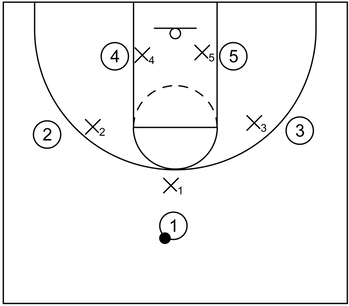
The offensive team is implementing a 3 out 2 in alignment, which features three players near perimeter areas of the court and two players near the low post areas.
Conversely, the defensive team employs a common type of defensive system known as man to man defense, which consists of each defender guarding a respective offensive player.
More brief information on man to man defense will be given in a later section but for the time being, the diagram is showcasing this particular type of defense, primarily for demonstrative purposes.
Additionally, for the adjacent diagram as well as subsequent diagrams in further sections through the web page, each offensive player is typically denoted by a number that represents a standard basketball position and each defensive player also has a correlated number to a similar position that is shown alongside the letter X.
In essence, 1 is the offensive point guard while X1 is the defensive point guard.
2 is the offensive shooting guard while X2 is the defensive shooting guard.
3 is the offensive small forward while X3 is the defensive small forward.
4 is the offensive power forward while X4 is the defensive power forward.
5 is the offensive center while X5 is the defensive center.
It should be also noted that 1 has possession of the basketball, which is represented by the black dot, and from that point, 1 is ready to initiate any particular offensive sequence.
What are fundamental elements of basketball defense
Defensive stance
General definition of defensive stance
The defensive stance comprises a type of athletic low posture utilized by one or more defensive players to more efficiently react to various actions by one or more offensive players, which, in turn, could also result in limited scoring opportunities.
Essentially, if one or more defensive players do not execute the proper defensive stance, then one or more offensive players would have a higher probability of scoring points.
Foundational components of a proper defensive stance
The foundational components that are vital for a defender to execute a proper defensive stance consists of feet that are slightly wider than shoulder width apart, knees that are slightly bent, and a back that is straightened as much as possible.
Each of these fundamental components within this type of athletic stance can help a defender maintain balance, which is essential to playing adequate defense.
Furthermore, each component can help a defender move in a swift, efficient manner, primarily by way of lateral sliding (more on that in another section below), which is also usually necessary while playing defense.
What’s more, a simple test that a player, especially a beginner, could utilize to generally determine if their overall posture is low enough is by attempting to use their wrist to make contact with their knee while performing the defensive stance.
In essence, if a player is able to touch their left and right knees with their left and right wrists respectively while executing the correct defensive stance, then that is usually an indicator of an athletic posture that is low enough.
Additional measures to implement after the proper defensive stance is established
After the proper defensive stance is firmly established, the defender should try to remain on the balls of their feet and not stand flat-footed.
This will also help the defender to react more efficiently to actions of one or more offensive players and it will also help the defender to slide laterally in an efficient manner as well.
Moreover, the defensive player should have their hands up with their arms extended away from the sides of their body.
Basically, when a defender has their hands up and extended away from the sides of the body, it is typically more difficult for an offensive player with or without possession of the basketball to easily and swiftly get around that defender.
Also, when the defender’s hands are up and away from the sides of the body, it is usually more likely that a defender would be able to properly contest a potential jump shot or any other type of field goal attempt that could be taken by an offensive player.
In addition to that, it is usually more challenging for an offensive player in possession of the basketball to pass it through the area of that defender, particularly towards the basket, which is also referred to as a penetrating pass or straight line pass.
Essentially, when a defender’s hands are up and extended and an offensive player attempts a penetrating or straight line type of pass towards the basket, that may result in a deflection or even possibly a steal for a defender.
It should also be mentioned that a defender should not touch an offensive player with illegal contact as that could lead to a defensive foul being assessed against that defender.
In essence, a defender should typically have their hands up and extended away from their sides but at the same time, the defender has to generally keep their hands within their own occupied space, which consists of an imaginary cylinder that surrounds that player from the floor to as far as they can jump or extend their arms above their head.
What’s more, the concept of the imaginary cylinder also applies to the offensive player and the diameter of the cylinder does not extend beyond any particular player’s hands/arms on the front side, a player’s rear on the back side, or the sides of a player’s legs.
Nevertheless, it is possible for a cylinder’s dimensions to change depending on the height and size of a player.
The diagram below attempts to demonstrate these additional measures.
Defensive players have hands up and extended away from sides while executing the proper defensive stance
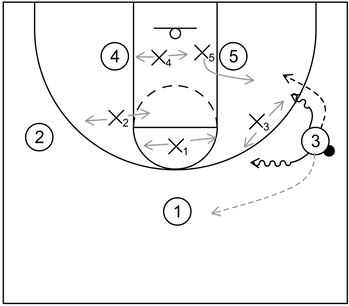
On the diagram, let’s first imagine that each of the defenders are within the correct defensive stance while remaining on the balls of their respective feet.
From there, let’s also imagine that the gray solid arrows represent the arms and hands of the various defenders.
By keeping the hands up and away from the sides of their bodies, the defenders can potentially cause difficulty for one or more of the offensive players.
To examine this more thoroughly, let us begin with the offensive player designated as 3, who initially has possession of the basketball near the right wing area.
X3, who is guarding 3 has hands up and away from the sides of their body. By doing that, X3 becomes wider than X3 actually is and the arm extension allows X3 to take up more space than X3 actually has as well.
As a result, 3 would have a much more challenging time easily getting around X3 by dribbling to the left near the free throw area or to the right near the baseline area, represented by the two arrows with wavy lines.
Furthermore, because X3 as well as the other defenders have their hands up and extended away from their sides, it would be typically risky for 3 to carelessly throw the ball to other teammates, most notably 2, 4, or 5.
If 3 were to lazily pass the ball to one of those teammates, then there is probably a moderate chance that pass would be deflected and/or intercepted by X1, X2, X3, or X4, generally depending on where the ball is thrown in that defender’s vicinity.
It should be mentioned as well that if the pass was intercepted, then that would also result in a turnover for the offensive team.
Ultimately, the defensive players would typically try to influence 3 to throw the ball to 1 near the middle of the half court at the top, which is represented by the gray dashed arrow.
This is generally referred to as a non-penetrating pass as it is thrown in the opposite direction of the basket. Additionally, this type of pass is usually beneficial for the defense because, at least in theory, the further the ball is away from the basket, the lower offensive shot percentages would become.
Next, let’s briefly switch focus to the other off-ball defenders.
X5 is fronting the low post on the high side by putting their right leg and right arm between the passing lane of 3 and 5. This is shown as the gray solid arrow directly under 5, who is near the right side low post area.
When that occurs, that also makes it more difficult for 3 to enter the ball easily into the low post in addition to the high hands and arm extension of X3.
X1 has hands up and extended away from the sides while protecting the center of the free throw line, which is also known as the nail (more details on nail defense in a later section).
This makes it more challenging for 3 to dribble towards the free throw area as X1 would be there to provide support for X3.
Furthermore, it is generally more arduous for 1 in particular to execute a basketball cut straight through that free throw line area while X1 is standing there.
Notice that X2 has hands up and extended away while standing near the left side of the lane line. This also potentially limits the ability of 2 to easily cut through the lane with little to no resistance.
X4 has hands up and extended away as a secondary rim protector alongside X5. While X4 covers that general area, it would typically be more difficult for 3 to throw the ball over the top of the defense, especially via a lob pass.
It should be mentioned as well that each of the off-ball defenders, especially those who are on the weak side of the court, opposite the ball, are also executing a tactic known as help defense. More details about that concept will be briefly explained in another section later.
Defensive sliding
General definition of defensive sliding
Defensive sliding consists of skilled action that occurs when a defender, initially within a defensive stance, moves their feet in a lateral fashion from side to side, ultimately to hinder offensive actions such as dribble penetration and reduce potential scoring opportunities.
Additional information in relation to defensive sliding
It should also be stated that a defender’s feet should never be too close together while performing the defensive slide as that would take away the defender’s lateral quickness.
Additionally, a defender should not cross their feet while performing the defensive slide.
If that were to occur, not only does this eliminate the defender’s ability to effectively slide laterally, but it also could cause the defender to lose balance.
Moreover, it is also noteworthy to mention that if a defender possesses poor lateral sliding mechanics and/or the defender’s lateral footwork is too slow, especially to stay in front of an offensive player, particularly one who is in possession of the basketball near a perimeter area of the court, then that could result in foul trouble for that defender by way of an accumulation of undesirable personal fouls.
The diagram below attempts to showcase an example of the defensive sliding concepts.
Defensive sliding vs. offensive player in their backcourt
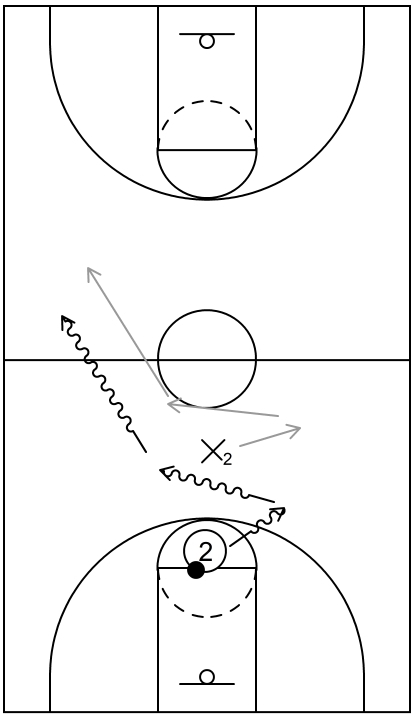
This is an example of defensive sliding against an offensive player who is in their backcourt during 1 on 1 action.
To begin, the offensive player, indicated as 2, initially dribbles toward the right side of the court. From there, the defensive player, designated as X2, reacts to that dribble action by sliding towards that same area, represented by the gray solid arrow.
The overall objective for X2 is to stay in front of 2 and contain the ball. So, if 2 switches direction such as via a crossover dribble towards the left side of the court, then X2 would react accordingly and follow that same pathway.
Defensive awareness
General definition of defensive awareness
Defensive awareness comprises a defender’s ability to see or know the general location of and react accordingly to three types of entities on the court, which are the ball, the defender’s primary assignment, as well as at least one additional defensive teammate.
In other words, a defender should generally be able to use their court vision to see or know where the ball is at, see or know the whereabouts of their primary assignment, and see or know the general locality of one or more teammates who should also be playing defense at that time.
Afterwards, that same defender should be able to respond appropriately, which could consist of various actions such as limiting dribble penetration, deflecting a pass, contesting an offensive player’s shot attempt, or helping another defensive teammate in some manner.
The diagrams below seek to showcase examples of good defensive awareness as well as bad defensive awareness.
Good defensive awareness: Defender sees ball and deflects pass during transition offense

This is an example of good defensive awareness that occurs during an opponent’s transition offense sequence.
Essentially, a defender is able to see and know where the ball, which then gives that defender an opportunity to deflect a pass.
Let’s also assume that the team currently executing their transition defense (more brief details on that concept in another section later) just missed a field goal attempt and as that happened, X1 immediately sprint back into the lane, ultimately to protect the basket.
Next, 5 collects the rebound and then 1 receives the ball from 5. Following that, 1 begins to dribble the ball down the court while X2 tries to prevent further dribble action, mainly by stopping the ball.
Unfortunately for the overall defense, 1 is able to blow by X2 with a dribble move such as a crossover and advance the ball further towards the basket.
Additionally, as that occurs, 2 sprints to the left side corner, 4 sprint to the left side slot area, and 3 begins to cut in towards the basket, all while other defenders seek to match up against a respective offensive player.
From there, 1 desires to throw the ball to 3 who could then potentially attack the rim and possibly draw a defensive foul on X1 near the basket.
However, as 1 throws the ball to 3, the adjacent defender X3 (who is moving towards and facing the basket) is not only able to see their primary assignment (3) but the ball as well, mainly via peripheral vision.
This is good defensive awareness and from there, X3 is able to use their left hand to deflect the pass so that 3 cannot receive it.
After that, X1 or X3 could potentially grab the loose ball, which would result in a turnover.
Also, as a side note, in terms of offensive awareness, it probably would have been more suitable if 2 received the ball from 1 instead of 3.
If that had happened, then 2 would have most likely had a wide open three-point jump shot opportunity as X1 would probably not have enough time to closeout (more brief details on the closeout concept later on) and contest the potential jump shot.
Bad defensive awareness: Defender does not see ball during baseline out of bounds play
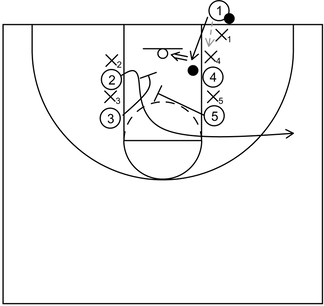
This is an example of bad defensive awareness that happens during the opposing team’s baseline out of bounds play.
Prior to the action, the offensive team initially utilizes a stack formation with two offensive players on each side of the lane and one offensive player standing behind the baseline in possession of the basketball, represented by the small black dot.
In terms of the defensive team, X1 is on the ball covering the inbound pass while the other defenders cover respective offensive players off the ball.
Nevertheless, for this particular example, let’s assume that X4 is facing 4 with their back towards the ball. In other words, X4 cannot see the ball, which is bad defensive awareness in general.
At the start of the action, 2 cuts to the right side wing area via a double screen set by 3 and 5.
Once that occurs, 3 would typically receive the ball via the throw-in from 1. However, let’s say that 1 notices that X4 does not see the ball because X4 is facing towards 4.
Next, 1 could throw the ball off the back of X4 who is not paying attention to the location of the ball. This is shown with the gray dashed arrow.
Afterwards, 1 can quickly step inbound, which is displayed by the solid black arrow. Following that, 1 can then gain possession of the ball again, which is represented by the second black dot inside of the lane area near the basket.
From there, 1 could quickly score via a close-range shot such as a layup, indicated by way of the wide arrow, before the defense has time to react properly.
Bad defensive awareness: Defender does not see assignment
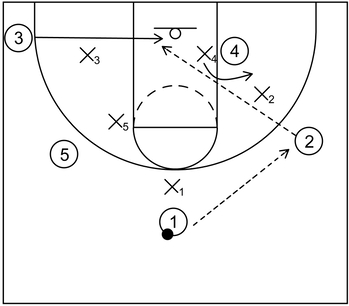
This is an example of bad defensive awareness that occurs when an off-ball defender does not pay attention to their adjacent assignment.
Essentially, as 2 receives the ball from 1, X3 on the weak side is able to see the ball. However, X3 cannot see their adjacent assignment (3), particularly by way of peripheral vision, because X3 is playing up too high.
This is bad defensive awareness overall from X3 and because of that error, 3 is able to cut to the basket, receive the ball from 2, and then score even before X4 is able to react quickly enough, primarily to block or contest the field goal attempt.
Defensive communication
General definition of defensive communication
Defensive communication generally comprises action on the court that happens when defenders are capable of utilizing spoken language and/or displaying symbols such as hand signals to converse and share information with each other, ultimately to limit or prevent the opposing team’s scoring opportunities.
For example, one defender could communicate with another defender to execute a defensive switch at the time of an offensive screen, ultimately to hinder that screen’s effectiveness, which could then limit scoring opportunities.
The diagram below seeks to illustrate an example of how defensive communication could be very useful in terms of limiting a scoring opportunity for the offensive team.
Defensive communication: Defender switches assignments with teammate to limit scoring opportunity
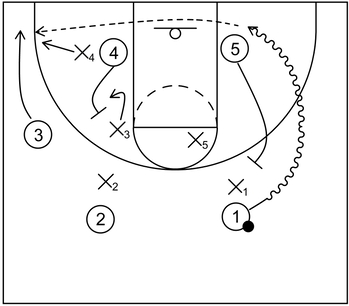
On the diagram, the offensive team desires to score points by way of an open three-point jump shot while the defensive team utilizes communication in an attempt to prevent that scoring opportunity.
At the start, 1 dribbles to the basket by way of an on-ball screen set by 5. As that happens, 3 cuts down to the left side corner on the weak side of the court via the off-ball screen set by 4.
However, as 4 begins to set the screen, X4 communicates with X3 that they should switch assignments due to the imminent screening action.
For example, X4 could simply say to X3 something such as “Screen coming! Switch!”
By doing that, X3 would be aware of both the imminent off-ball screen and that X4 will switch to 3 while X3 should remain near 4 immediately after the screen is set.
Conversely, if X4 did not communicate to X3 that the screen of 4 was coming, then it is very likely that 3 would get open for a possible three-point jump shot.
Fortunately, for the defense at least, 3 is not wide open upon receiving the ball from 1 because X4 has switched with X3.
It should also be mentioned as a side note that the offensive sequence on the diagram is generally referred to as the hammer set play or hammer action.
Defensive sub-systems
Generally speaking, there are two primary types of defensive sub-systems within the larger overall system of basketball defense.
These primary types of sub-systems are typically referred to as full court defense and half court defense.
What’s more, there are also secondary types of sub-systems within the primary sub-systems of full court and half court defense.
Those secondary sub-systems are commonly known as man to man defense and zone defense.
Furthermore, there is also a hybrid sub-system that combines elements of the secondary sub-system, which is generally known as junk defense.
Full court defense
Full court defense, also generally referred to as a full court press, is a defensive system that focuses on carrying out specific strategies that implement backcourt and/or frontcourt defensive pressure against the offensive team.
Moreover, defenders can also utilize the full court press to trap a player in possession of the basketball, particularly near sidelines or corners of the court.
Generally speaking, the main goal of the full court defense is to disrupt offensive flow and potentially create turnovers, which could possibly result in easier or at the very least, extra scoring opportunities, once the former defensive team gains possession of the ball.
The image below showcases an example of a typical full court press defense, known as the 1-2-1-1 press.
Nevertheless, more details about the current example as well as other specific full court pressure defensive strategies are given in another section later on.
Full court defense example: 1-2-1-1 press initial formation
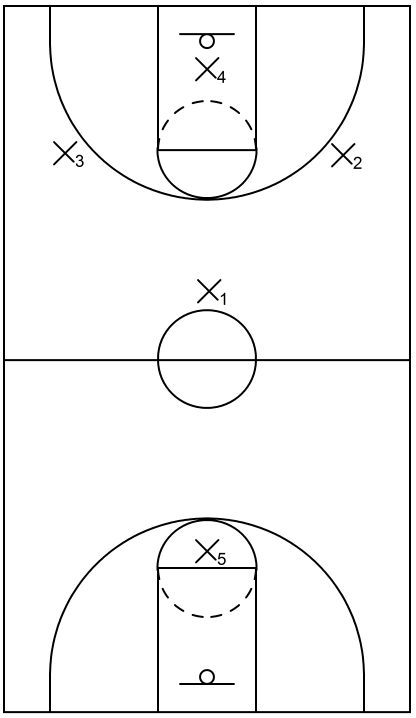
This is an example of a full court defense that features a 1-2-1-1 initial formation.
Essentially, one defensive player is at the top or point of the full court defense. Two defensive players are located near the wing areas on each side of the court.
Another defensive player is positioned at the middle of the court near the half court line. From there, there is a final defender positioned near the free throw line as a safety of sorts for rim protection.
Half court defense
Half court defense is a defensive system within the game of basketball that typically comprises a variety of different defensive strategies and tactics within the half court, which would also be the offensive team’s frontcourt, that are utilized by a defensive team, ultimately to limit or prevent offensive scoring opportunities near the basket or near perimeter areas.
It should be noted as well that offensive scoring opportunities within the half court can be limited or possibly prevented altogether by hindering dribble and pass penetration as well as protecting the basket.
Basic defensive actions to hinder dribble penetration
Generally speaking, defensive players can hinder offensive dribble penetration by simply getting into a proper defensive stance and executing proper defensive sliding techniques as mentioned earlier.
From there, an on-ball defender can stay in front of the offensive player in possession of the basketball while other off-ball defenders can provide help if necessary to further inhibit dribble penetration.
Basic defensive actions to hinder pass penetration
Defenders can primarily hinder pass penetration (which are offensive passes that are thrown towards the basket) by keeping hands up and extended away from their sides while executing the proper defensive stance.
Additional secondary ways to hinder pass penetration is by executing zone defense (more brief details on that in a later section) or via fronting the offensive low post player, particularly by placing one leg and one arm between the passing lane of the low post player who would like to receive the ball and the offensive player who would be currently in possession of it.
Basic defensive actions to protect the basket
The defensive team can primarily protect the basket by always having at least one defender near the basket whenever possible, regardless of the defensive sub-system and/or defensive strategy that would be implemented.
Essentially, by placing at least one defensive player near the basket, that should, at least in theory, prevent the offensive team from easily scoring points near or within the lane/paint area without any sort of defensive resistance.
In other words, if there is not at least one defender near the basket, then an offensive player in possession of the basketball could pass it to a teammate who is around that lane/paint area for a potential scoring opportunity or that same offensive player with the ball could simply attack the rim and possibly score themselves.
Man to man defense
Man to man defense is a type of defensive system that emphasizes each defender guarding a certain offensive player, typically based on their respective basketball positions, to ultimately limit or prevent scoring opportunities near the basket or near the perimeter areas of the court.
Some key principles within man to man defense include executing the proper defensive stance and defensive slide, limiting dribble penetration as much as possible, protecting the basket, executing proper closeouts and stunts, executing good denial defense, and jumping to the ball when necessary.
There are also some variations of standard man to man defense such as the pack line defense. However, more brief details on these variants will be revealed in a later section below.
The diagram below shows a very basic example of man to man defense vs. an offensive strategy, commonly known as Horns offense.
Man to man defense example vs. Horns offense

On the diagram, each defender defends against a respective counterpart. So, X1 defends against 1 near the top. X2 and X3 defends against 2 and 3 respectively near the corners. Additionally, X4 and X5 defend against 4 and 5 near the high post areas.
Zone defense
Zone defense is a type of defensive system in basketball that consists of each defender guarding a certain area on the court and by extension, any offensive player that enters into that zone defender’s respective area, ultimately to limit dribble penetration, restrict low post scoring opportunities, and influence jump shots, particularly from offensive teams with below average perimeter shooting abilities.
There are also various zone defense strategies to consider such as the 1-3-1 zone, the 2-3 zone, and the 3-2 zone among others.
Very brief details about those zone strategies will be covered in another section later on.
Junk defense
Junk defense is a unique type of defensive system in basketball that integrates certain elements of man to man defense alongside certain elements of zone defense to limit or prevent scoring opportunities of the offensive team.
Junk defense can be potentially advantageous as a method to hinder offensive productivity and efficiency from one or two of the opposing team’s best players, especially if most of the offensive team’s scoring load comes from perimeter-oriented players such as the point guard, shooting guard, or small forward.
The primary types of junk defense strategies include the box and 1 defense, the diamond and 1 defense, and the triangle and 2 defense.
Very brief details about those strategies will be disclosed in a section below at a later time.
Defensive strategies
Defensive strategies in basketball comprise planned actions based on various defensive sub-systems that are implemented by the coaching staff and generally utilized by all five defensive players on the floor to reach the ultimate objective of limiting or preventing the offensive team’s scoring productivity.
The information below gives a few details on the various defensive strategies that could be implemented during a basketball game.
1-1-2-1 press defense
The 1-1-2-1 press defense is a basketball defensive strategy that emphasizes backcourt ball pressure and frontcourt sideline traps to disrupt offensive flow, which could reduce scoring opportunities and create turnovers.
The diagram below demonstrates a typical initial formation of the 1-1-2-1 press defense.
1-1-2-1 press defense: Initial formation
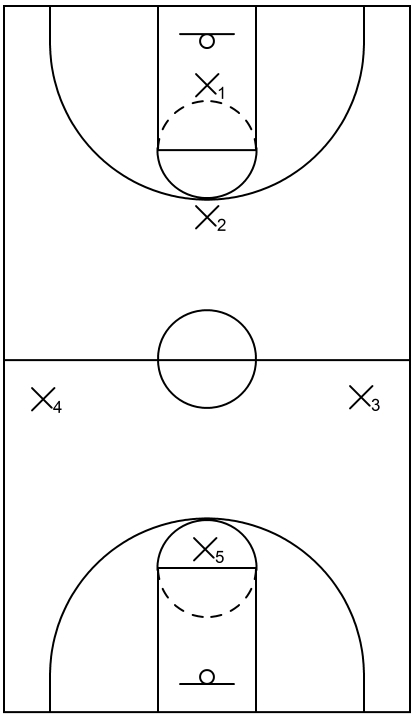
At the start, X1 begins in the offensive team’s backcourt inside of the lane between the baseline and the dotted half circle. X2 also begins in the backcourt, but at the top of the three-point arc.
X3 and X4 begin on the opposite within the offensive team’s frontcourt near the half court line and sidelines while X5 begins in the frontcourt near the high post area.
1-1-3 press defense
The 1-1-3 press defense is a basketball defensive strategy that uses on-ball pressure and sideline traps to disrupt offensive flow, which in turn, limits scoring opportunities and generates turnovers.
The diagram below demonstrates a typical initial formation of the 1-1-3 press defense.
1-1-3 press defense: Initial formation
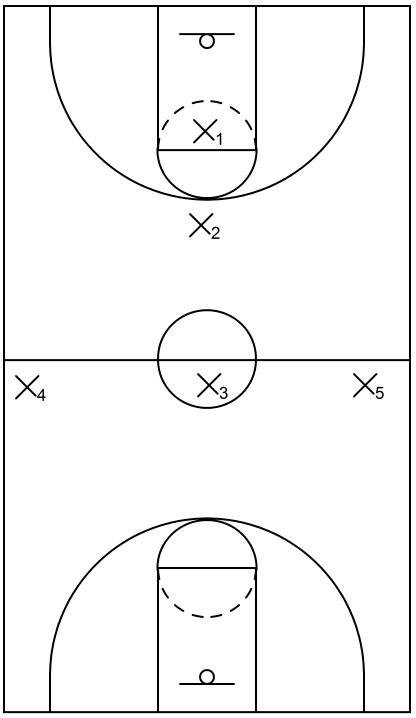
Within the offensive team’s backcourt, X1 starts slightly below the free throw line while X2 starts at the top above the three-point arc.
Within the offensive team’s frontcourt, X3 starts near the center of the court while X4 and X5 cover the corners near the half court line.
1-1-3 zone defense
The 1-1-3 zone defense is a basketball defensive strategy that seeks to prevent low post scoring opportunities while influencing contested field goal attempts and limiting dribble penetration with on-ball pressure, particularly near the perimeter at the top.
The diagram below showcases a typical initial formation of the 1-1-3 zone.
1-1-3 zone defense: Initial formation
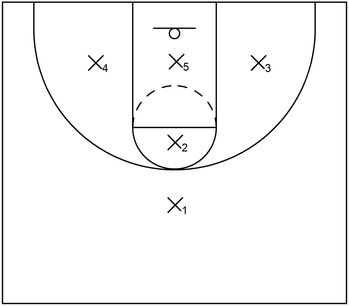
X1 begins at the top of the zone above the three-point line. X2 begins near the high post area.
X3 and X4 start inside of the three-point line but extended out from the low post blocks. X5 starts inside of the lane area in front of the basket.
1-2-1-1 press defense
The 1-2-1-1 press defense is a basketball defensive strategy that features full court pressure and sideline traps, particularly in the backcourt, which could lead to limited scoring opportunities as well as possible turnovers for the offensive team.
The diagram below demonstrates a typical initial formation of the 1-2-1-1 press.
1-2-1-1 press defense: Initial formation
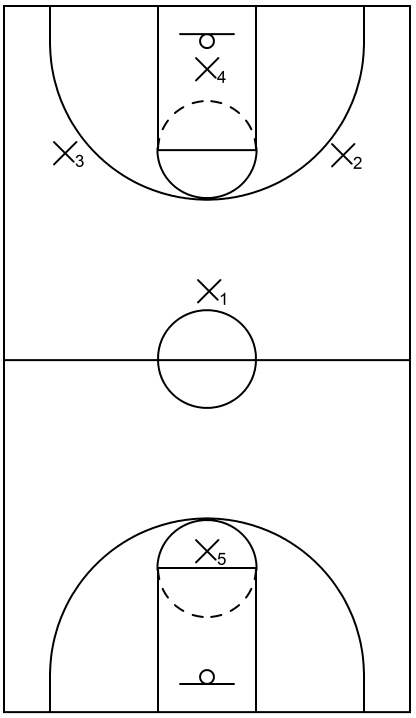
X4 starts inside of the lane area within the offensive team’s backcourt. X3 and X2 begin near the wing areas adjacent to the three-point line.
X1 starts near the half court line just below the center circle. Lastly, X5 starts near the high post area on the opposite side of the floor in the offensive team’s frontcourt.
1-2-2 press defense
The 1-2-2 press defense is a basketball defensive strategy that features sideline traps, particularly in the backcourt or frontcourt, which in turn, could limit offensive scoring opportunities.
The diagram below showcases a typical initial formation of the 1-2-2 press defense.
1-2-2 press defense: Initial formation
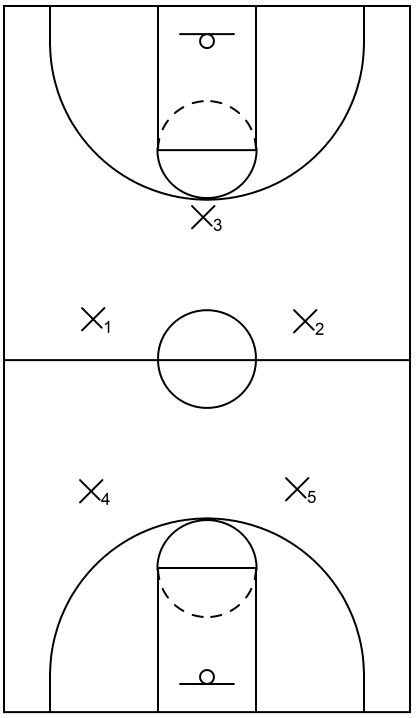
Within the offensive team’s backcourt, X3 starts at the top above the three-point line while X1 and X2 start slightly above the half court line near the extended slot areas.
Within the offensive team’s frontcourt, X4 and X5 start above the three-point line near the slot areas.
1-2-2 zone defense
The 1-2-2 zone defense is a basketball defensive strategy that seeks to limit low post scoring opportunities, restrict dribble penetration, and influence inferior perimeter shot selection while executing on-ball pressure, particularly near the perimeter.
The diagram below shows a common initial formation of the 1-2-2 zone defense.
1-2-2 zone defense: Initial formation
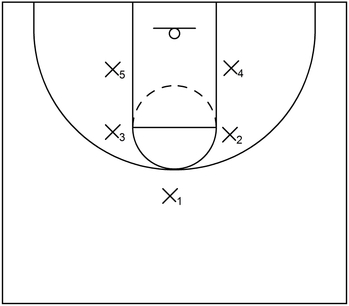
X1 starts at the top above the three-point line. X2 and X3 start near the high post elbow areas. X4 and X5 start near the low post blocks.
1-3-1 press defense
The 1-3-1 press defense is a type of basketball defensive strategy that utilizes on-ball pressure and implements traps near the sidelines in the frontcourt to limit or prevent offensive scoring opportunities.
The diagram below demonstrates a typical initial formation of the 1-3-1 press defense.
1-3-1 press defense: Initial formation
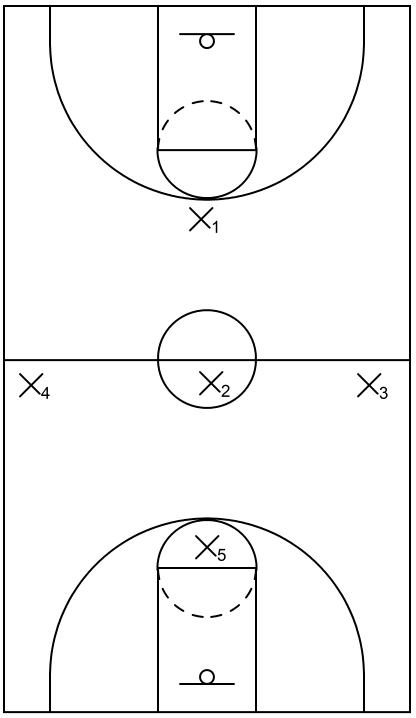
Within the offensive team’s backcourt, X1 starts at the top above the three-point line.
Within the offensive team’s frontcourt, X2 starts near the half court center circle.
Also, X3 and X4 start near the half court corners while X5 starts near the high post area.
1-3-1 zone defense
The 1-3-1 zone defense is a basketball defensive strategy that seeks to disrupt offensive scoring opportunities by influencing contested perimeter jump shots and limiting dribble penetration, while executing solid on-ball defense.
The diagram below showcases a typical initial formation of the 1-3-1 zone defense.
1-3-1 zone defense: Initial formation
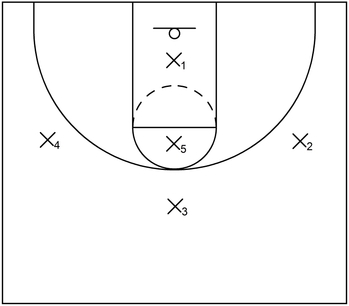
X3 begins at the top above the three-point line. X2 and X4 start near the wings. X5 starts near the high post and X1 starts near the basket within the lane area.
2-1-2 press defense
The 2-1-2 press defense is a basketball defensive strategy that implements traps near the sidelines to disrupt the scoring effectiveness of the offensive team with the additional possibility of creating turnovers.
The diagram below demonstrates a typical initial formation of the 2-1-2 press defense.
2-1-2 press defense: Initial formation
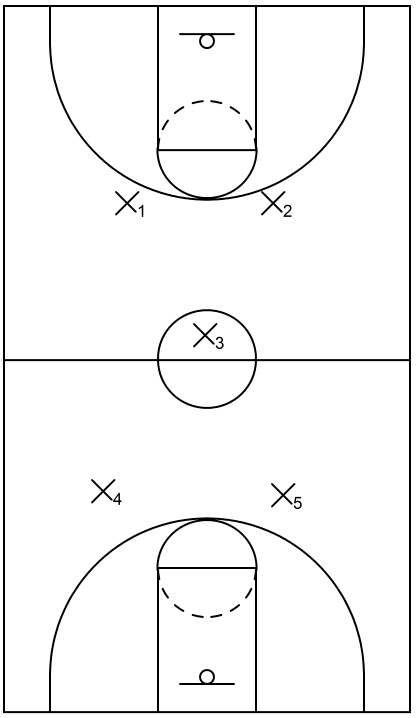
Within the offensive team’s backcourt, X1 and X2 start above the three-point arc near the slot areas while X3 starts near the half court line.
Within the offensive team’s frontcourt, X4 and X5 start above the three-point arc near the slot areas.
2-1-2 zone defense
The 2-1-2 zone defense is a basketball defensive strategy that seeks to limit dribble penetration, influence contested perimeter jump shots, and reduce offensive scoring opportunities, particularly from the low post areas, while executing sufficient on-ball defense.
The diagram below showcases a common initial formation of the 2-1-2 zone defense.
2-1-2 zone defense: Initial formation
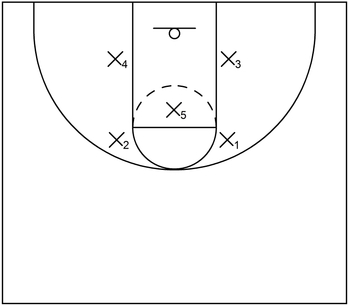
X1 and X2 start near the high post elbow areas. X5 starts slightly below the free throw line in the lane area while X3 and X4 start near the low post areas.
2-2-1 press defense
The 2-2-1 press defense is a basketball defensive strategy that seeks to limit offensive scoring opportunities with the possibility of creating turnovers by way of sideline traps in the backcourt or frontcourt.
The diagram below demonstrates a common initial formation of the 2-2-1 press defense.
2-2-1 press defense: Initial formation
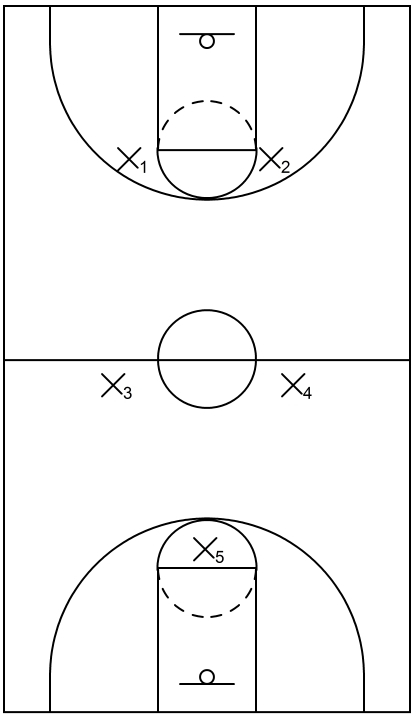
Within the offensive team’s backcourt, X1 and X2 start near the high post elbows inside of the three-point arc.
Within the offensive team’s frontcourt, X3 and X4 start near the half court line at the extended slots. Furthermore, X5 starts near the high post area.
Nonetheless, it should be noted that X3 and X4 could also start near the half court line in the backcourt and additionally, X5 has the option to drop back into the lane if an offensive player cuts below the free throw line extended areas.
2-3 zone defense
The 2-3 zone defense is a basketball defensive strategy that seeks to limit dribble penetration, influence contested perimeter jump shots, and decrease offensive scoring opportunities, particularly from the low post areas, while executing adequate on-ball defense.
The diagram below shows a typical initial formation of the 2-3 zone defense.
2-3 zone defense: Initial formation

X1 and X2 start near the high post areas. X3 and X4 start near the low post areas while X5 starts inside of the lane in front of the basket.
3-2 zone defense
The 3-2 zone defense is a basketball defensive strategy that emphasizes the prevention of low post scoring opportunities while restricting dribble penetration with adequate on-ball defense and influencing poor shot selection, particularly from the perimeter.
The diagram below showcases a common initial formation of the 3-2 zone defense.
3-2 zone defense: Initial formation
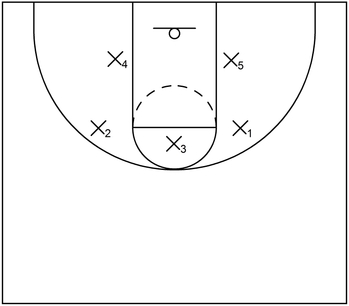
X3 starts near the high post area while X1 and X2 start near the free throw line extended areas but inside of the three-point arc. Also, X4 and X5 start near the low post areas.
Amoeba defense
The Amoeba defense is a basketball defensive strategy that seeks to limit scoring opportunities for the offensive team by implementing on-ball pressure as well as sideline traps while preventing dribble penetration from the perimeter and restricting entry passes into the high or low post areas.
The diagram below demonstrates an initial formation of the Amoeba defense.
Amoeba defense: Initial formation
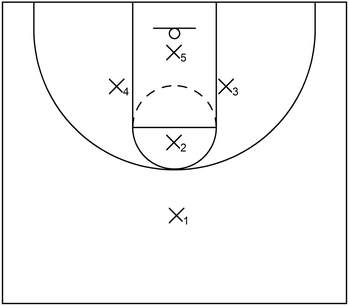
X1 starts at the top while X2 begins near the high post area. X3 and X4 start near the mid-post areas between the high post elbows and low post blocks. X5 starts inside of the lane in front of the rim.
Ball line defense
The ball line defense is a basketball defensive strategy, developed by Coach Tubby Smith that implements on-ball defensive pressure and off-ball help defense principles to limit scoring opportunities near the basket while influencing contested perimeter jump shots.
The diagram below showcases an example of ball line defense action when an offensive player is in possession of the ball at the top in the frontcourt.
Ball line defense: Offensive player has possession of the ball at the top
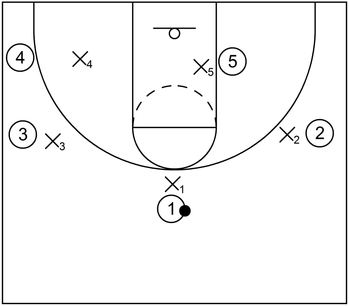
X1 executes defensive pressure against 1. As that happens, X2 and X3 place a hand in the passing lanes near 2 and 3, ultimately to make it more difficult for those players to easily receive the ball in terms of continuing offensive flow.
X4 could take a step away from 4 near the left corner to provide off-ball help defense in the possible event that 2 or 3 decides to cut to get open near the basket.
X5 guards against 5 while also focusing on protecting the rim as well.
Box and 1 defense
The box and 1 defense is a basketball defensive strategy and a type of junk defense that seeks to limit scoring opportunities, especially for the opposing team’s best player, by implementing a combination of man to man and zone defense principles.
The primary objective of the box and 1 defense is for the defensive team to utilize their best defender to disrupt or neutralize the scoring and/or playmaking abilities of the offensive team’s best player.
Also, at the same time, the additional four defenders play a zone defense in the form of a box, hence the name of box and 1.
The diagram below demonstrates an initial formation of the box and 1 defense.
Box and 1 defense: Initial formation
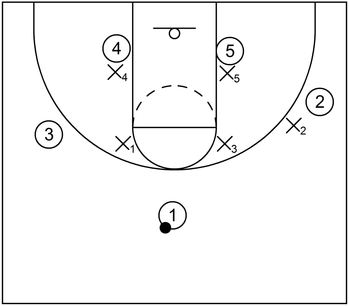
In this particular instance, X2 is the chaser and therefore, guards the target, who is player 2, near the right side wing, with man to man defense.
X1 and X3 are the zone defenders at the top of the box and they are initially adjacent to the elbows of the high post.
Similarly, X4 and X5 are the zone defenders at the bottom of the box and they start near the low post areas.
Diamond and 1 defense
The diamond and 1 defense is a basketball defensive strategy, a type of junk defense, and a variation of the box and 1 defense that seeks to limit scoring opportunities, particularly for the opposing team’s best player, by implementing a combination of man to man and zone defense principles.
The diagram below demonstrates an initial formation of the diamond and 1 defense.
Diamond and 1 defense: Initial formation
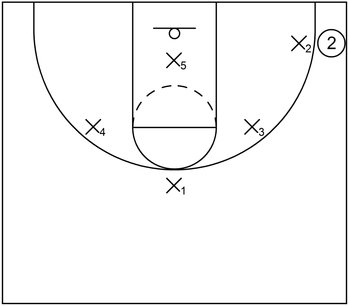
In this particular instance, X2 is the chaser and therefore, guards the target, who is player 2, near the right side corner, with man to man defense.
The other four defenders form a diamond. Therefore, X1 is at the top of the diamond while X3 and X4 are near the high post extended elbows adjacent to the wings.
Also, X5 is at the bottom of the diamond in front of the basket within the lane area.
Havoc press defense
The havoc press defense is a basketball defensive strategy, developed by Coach Shaka Smart, that utilizes on-ball pressure and defensive traps, particularly in the backcourt, with a main objective of influencing the offensive team to play at a faster pace than usual, which could then lead to turnovers by that same offensive team.
The diagram below displays the initial formation of the Havoc press defense.
Havoc press defense: Initial formation
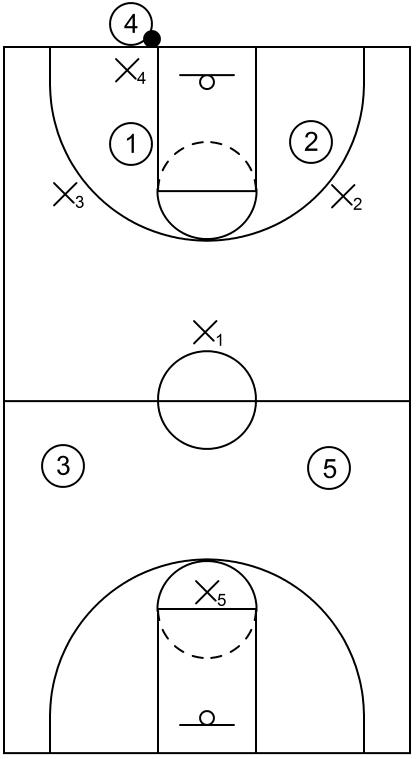
Within the offensive team’s backcourt, X4 starts near the baseline and executes immediate defensive pressure against the player executing the inbound pass.
Also, X3 and X2 start near the wing areas while X1 begins near the center circle.
Moreover, within the offensive team’s frontcourt, X5 starts near the high post area.
Pack line defense
The pack line defense is a basketball defensive strategy that implements a combination of on-ball defensive pressure, help defense, and denial defense to limit or prevent offensive scoring opportunities, primarily by hindering low post touches and influencing contested perimeter jump shots.
The diagram below demonstrates an example of the pack line defense when an offensive player has possession of the ball at the top in the frontcourt.
Pack line defense: Offensive player has possession of the ball at the top
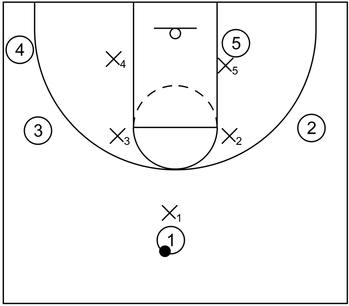
This is an example of the pack line defense when the ball is live at the top. That is to say, 1 is currently dribbling the ball and has not ended the dribble. To begin, X1 applies on-ball pressure against 1.
As that occurs, the other four defenders are inside of the pack line. That is, X2 and X3 are currently near the high post elbows while X4 and X5 are currently near the low post areas.
Additionally, X5 could also execute a three quarter front or complete low post front on the high side of 5, near the basket.
Point zone defense
The point zone defense is a basketball defensive strategy that emphasizes on-ball defensive pressure as well as off-ball zone defensive principles to ultimately limit or completely eliminate offensive scoring opportunities.
The diagram below demonstrates an example of the point zone defense when an offensive player has possession of the ball at the top in the frontcourt.
Point zone defense: Offensive player has possession of the ball at the top
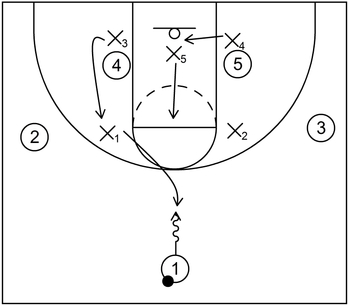
Initially, before implementing on-ball pressure or defensive rotations, each of the defenders should have their hands up and extended away from their sides to discourage entry passes into the high post or towards the basket from the top.
Next, as 1 dribbles the ball closer to the three point line at the top, X1 calls point and steps up to implement defensive pressure.
As that occurs, X3 also lifts to fill the vacated space near the left side high post. This essentially means that if 2 were to receive the ball from 1, then X3 would be ready to cover that area if necessary.
Furthermore, as the on-ball defensive pressure occurs, X5 could momentarily step up towards the bottom of the free throw line to further discourage cutting action, particularly towards the high post area, by any of the off-ball offensive players.
Moreover, X4 could temporarily slide into the lane to offer additional rim protection while X1 continues to implement defensive pressure against 1.
Run and jump defense
The run and jump defense is a basketball defensive strategy utilizes man to man principles, defensive traps near the sidelines, and the switch defensive tactic, particularly in the backcourt, to disrupt offensive flow and limit scoring opportunities near the basket or from the perimeter.
The diagram below showcases an example of the run and jump defense when an offensive player gains possession of the ball while in their backcourt.
Run and jump defense: Offensive player has possession of the ball in their backcourt
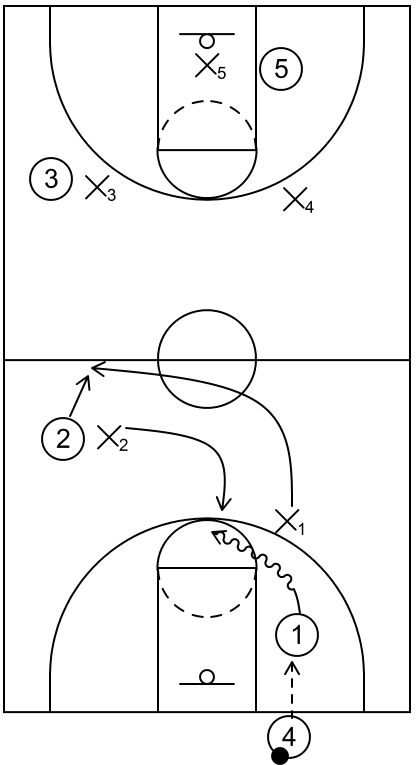
This is an example of the two-man switch within the run and jump defense. To start, 1 receives the ball from 4 in the backcourt and when that happens, X1 does not implement defensive pressure yet but instead, stays beyond the three-point line.
Next, 1 decides to dribble towards the middle of the court. When that occurs, X2 covers 1 with an automatic jump switch while X1 exchanges to guard 2. Also, X1 is able to switch before 2 moves into the frontcourt.
Transition defense
Transition defense is a special type of defensive strategy in basketball that gets initiated when a certain team will convert from an offensive focus to a defensive-minded one and quickly sprint into the other team’s frontcourt to protect their own basket.
The primary purpose of this is to limit or totally prevent the offensive team from generating easy scoring opportunities, particularly at the rim by way of transition offensive strategies, generally known as primary break, numbered fast break, or secondary break.
Triangle and 2 defense
The triangle and 2 defense is a basketball defensive strategy and a type of junk defense that seeks to limit scoring opportunities, primarily for the opposing team’s two best perimeter players, by implementing a combination of man to man and zone defense concepts.
The diagram below showcases an example of the triangle and 2 defense when the offensive team’s third best player has possession of the basketball at the top in the frontcourt.
Also, for this particular situation, the offensive team implements the 5 out motion offense for demonstrative purposes.
Triangle and 2 defense: Offensive player has possession of the ball at the top
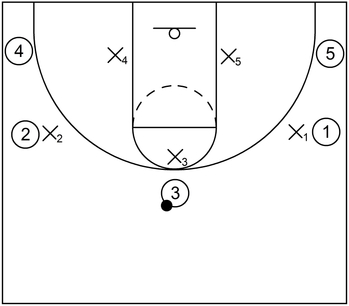
X3 puts a certain amount of defensive pressure on 3, who currently has possession of the ball, while X4 and X5 stay near the low post areas. This also forms the defensive triangle between X3, X4, and X5.
In addition to that, X1 and X2 place one of their hands in the passing lanes of 1 and 2 so that it is potentially more difficult for those players to easily receive the ball from 3.
Defensive tactics
Defensive tactics in basketball comprise effective and practical actions that are executed to create an favorable outcome for the defensive team as a whole.
Also, defensive tactics are generally performed by at least one defender at specific times but usually not by the entire team at the same time.
The information below gives a few details on the various defensive tactics that could be implemented during a basketball game.
Closeout
A closeout is a defensive tactic in basketball that occurs when an on-ball defender will quickly close the open space on the court between themselves and an adjacent offensive player with the ball in an effort to limit or prevent an uncontested jump shot or dribble penetration towards the basket.
The primary technique to execute a closeout is for the on-ball defender to sprint towards the offensive player with the ball, particularly with long steps, while maintaining a good defensive stance.
Furthermore, the on-ball defender should use short choppy steps upon completely closing the space between themselves and the offensive player with the ball.
The choppy steps allow the defender to slow down their sprinting speed in an effort to not make unnecessary contact with the offensive player with the ball, which could lead to a needless foul.
Additionally, at the same time, this also allows the defender to properly read and react to any potential actions of the offensive player, whether those actions be a jump shot, dribble penetration, or a possible pass to another offensive player.
The diagram below demonstrates a basic example of a closeout from a defender who is initially on the weak side of the court.
Weak side defender executes closeout to the adjacent corner
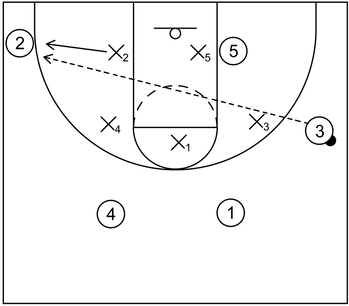
To start, 3 has possession of the basketball near the right side wing area while the defense executes the proper stance.
Following that, 3 throws the ball across the court via a skip pass towards 2.
As that occurs, X2 is able to closeout on the ball, represented by the solid black arrow, and limit or totally prevent a potential wide open jump shot from 2.
Denial defense
Denial defense, sometimes referred to as denying the pass or denying the ball, is a defensive tactic in basketball that occurs when an off-ball defender, typically one pass away adjacent to the player in possession of the ball, prevents the offensive player that they are currently guarding from receiving the ball.
The main purpose of the denial defense is to disrupt the flow of the offensive team, especially if the offensive player being denied is one of the offensive team’s best players.
To properly perform the denial defense, the defender should put the foot that is opposite the ball in the middle of the denied offensive player’s body, usually between the feet of that same offensive player.
Additionally, the defender should place the other foot that is closest to the player with the ball slightly above the offensive player that is being denied.
Next, the defender should place the forearm that is opposite of the player with the ball on the chest of the offensive player that is being denied.
Afterwards, the defender should have their arm and hand that is closest to the ball fully extended in the passing lane between the offensive player being denied and the player with the ball.
Moreover, the defender should have the palm of their hand towards the ball. In other words, the defender should be able to see the back of their hand and not their palm.
This basically helps the defender deflect the ball if the player in possession of the ball attempts to pass it to their teammate who is being denied.
The first diagram below attempts to demonstrate a very basic example of denial defense within 3 on 3 action.
The second diagram attempts to show how the offensive team could potentially counter the denial action.
Defender denies pass attempt to wing area
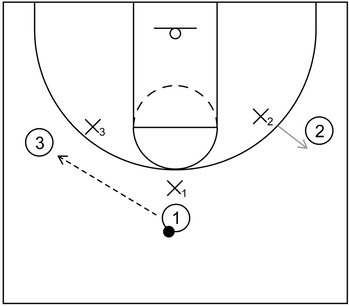
On the simple diagram, let’s imagine that 2, who is near the right side wing would like to receive the ball from 1.
However, let’s also say that X2 is denying that pass, which is represented by the gray arrow.
From there, because 2 is not open to receive the ball, then 1 would have to throw it instead to 3.
It should be mentioned though that 2 could counter the denial action with the backdoor cut.
However, if X2 is able to anticipate the cut properly and continue to utilize good defensive mechanics in terms of remaining in a stance and laterally sliding correctly, then it may not be as effective as the offensive team would hope.
Double Team
The double team is a defensive tactic in basketball that occurs when an offensive player in possession of the ball receives simultaneous defensive pressure from a primary defender and a secondary defender, with the ultimate objective of limiting scoring opportunities, particularly near the basket or from the perimeter.
To execute the double team, the secondary defender should typically wait until after the player in possession of the ball has already started their dribble or just finished their dribble.
If the player in possession of the ball started their dribble, then the defensive pressure from the double team could cause them to prematurely pick up their dribble.
When that mistake occurs, that same offensive player could compound the problem by executing a bad pass, which then could lead to a turnover.
Likewise, if the player in possession of the ball already ended their dribble, then the double team pressure could cause that same player to attempt to get rid of it impulsively leading to a intercepted pass or some other type of turnover such as a traveling violation.
Afterwards, the primary defender and secondary defender should lock their adjacent feet next to each other as a method to prevent a potential dribbling escape route for the player who has the ball.
Following that, the primary defender and secondary defender should use high hands up and extended away from their sides.
This could lead to more difficulty for the player in possession of the ball to see potential passing options to alleviate pressure from the double team action.
Moreover, the primary defender and secondary defender should use their hands to mirror the hands of the player with the ball.
As a result of mirroring, one of the defenders could possibly deflect an attempted pass and this could lead to a turnover.
Additionally, it is important for the primary defender and secondary defender to not reach for the ball in an attempt to steal it.
This could result in an unnecessary defensive foul being assessed to either the primary defender or secondary defender.
The diagram below attempts to demonstrate a basic example of a double team.
Primary and secondary defender execute a double team near the low post area
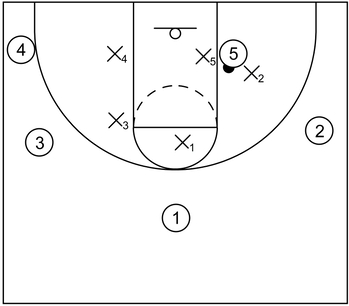
On the diagram, X5 is the primary defender who is guarding 5. Additionally, X2, who is the secondary defender, slides down near the low post area to execute a double team with 5.
In this instance, the defense is attempting to influence 5 to pass the ball back towards 2.
There is also an assumption that 2 possesses a below average jump shot because X2 is helping one pass away, which is usually not beneficial for the defense.
Drop Coverage
Drop coverage in basketball is a tactic that occurs when a certain defensive player drops below an on-ball screen that is set by an offensive player whom that same defensive player is currently guarding, ultimately to limit pick and roll scoring opportunities.
Additionally, the offensive player setting the on-ball screen is generally referred to as the screener while the defensive player guarding that same offensive player is generally known as the screener’s defender, .
The drop coverage is typically most effective when the offensive players involved in the pick and roll action possess below average jump shots or when the screener commonly prefers to always roll to the basket as opposed to popping out to a perimeter spot on the court.
The diagram demonstrates a very basic example of drop coverage within 2 on 2 action.
Basic drop coverage within 2 on 2 action
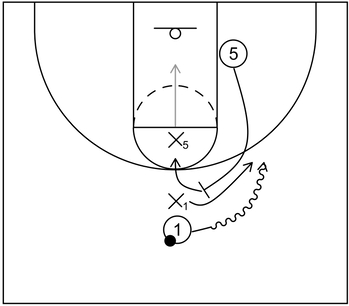
On the diagram, X5 drops below the on-ball screen set by 5 and initially remains slightly above the free throw line area.
Following that, as 1 utilizes the screen, X1 fights over the top of the screen while 5 begins to roll to the basket.
However, X5 is able to impede that roll action by cutting off the desired pathway for 5.
Also, as a secondary defensive action, X5 could also backpedal into the lane area and towards the basket, which is represented by the gray arrow.
X5 might employ this variant of the drop coverage tactic if 1 prefers to dribble towards the basket while X5 intends to roll to that same destination.
Hedge
The hedge, also known as hedge and recover, is a basketball defensive tactic that occurs when a screener’s defender obstructs the intended dribbling route of the screen receiver, generally by lifting above the on-ball screen, and afterwards, that same defender typically recovers to the screener.
Help defense
Help defense is a basketball defensive tactic that occurs when off-ball defenders support the on-ball defender to ultimately limit or prevent potential scoring opportunities of the offensive team.
Additionally, help defense can be useful for mitigating dribble penetration as well as hindering offensive cuts to the basket.
Help defense consists of adjacent off-ball defenders that are one pass away from the ball as well as additional off-ball defenders that are two or more passes away from the ball.
When the ball is one pass away, the help defender will initially jump to the ball as a way of limiting or preventing certain scoring options by the adjacent offensive players.
Also, when the ball is at least two passes away, the help defenders, near the top, the wing opposite the ball (i.e. the weak side wing), and/or the corner opposite the ball (i.e the weak side corner) should slide laterally towards the center of the free throw line (i.e. the nail), the weak side high post, and/or the weak side low post area respectively.
Moreover, in some instances, when the ball gets passed to a side of the floor, an offensive player may not occupy the low post area on that same side, such as the 5 out formation.
When that happens, an off-ball help defender, preferably one that is lower on the court, such as a weak side corner defender, could slide into the lane to protect the basket.
Furthermore, if an off-ball help defender slides into the lane to protect the basket, then an additional help defender on that same side of the court could drop back to stand in the gap between the weak side mid-post and the weak side corner.
The primary purpose of standing in the weak side gap is to provide additional help defense if necessary, which is known as help the helper.
In simple terms, help the helper basically means an off-ball defender that gives initial help will receive secondary help themselves from another off-ball defender, particularly after offensive dribble penetration occurs.
Ice defense
Ice defense is a basketball defensive tactic that focuses on limiting scoring options from the side pick and roll action of the player with the ball as well as the screener who would typically roll to the basket after setting the screen.
To execute the ice defense, the on-ball defender will jump above the screen, parallel to the sideline, before it can be fully set as opposed to fighting through it or going under it.
Also, the screener’s defender should stay below the screen near the free throw line extended area inside of the three-point line.
The ice defense influences the offensive player with the ball towards the baseline and away from the screening action.
As a result, this takes away dribble penetration towards the middle of the court and it also potentially limits the scoring opportunities of the offensive team as the ball is only on one side of the court.
Nail defense
Nail defense, also known as protecting the nail, is a basketball defensive tactic that occurs when a certain defender covers the area near the center of the free throw line (i.e. the nail) to limit or prevent dribble penetration, particularly from the wings.
Essentially, the nail protection hinders the offensive team’s ability to drive the ball towards the middle of the lane, thus diminishing multiple scoring options from both sides of the floor.
Shoot the gap
Shoot the gap is a basketball defensive tactic that occurs when an off-ball defender, typically adjacent to the baseline, will evade certain types of screens by going under them with the primary purpose of hindering a screen receiver’s opportunity to catch the ball while wide open.
Stunt
A stunt is a basketball defensive tactic that occurs when an off-ball defender, usually one pass away from the ball, will temporarily take a step towards the player with the ball, particularly during dribble penetration, for about a half-second and then recover to the offensive player that they were originally guarding.
The stunting action is mainly used to restrict dribble penetration but it can also be used to disrupt low post scoring opportunities, thus protecting the basket.
Switch defense
Switch defense is a basketball defensive tactic that occurs when two defenders exchange the offensive players that they are currently guarding to ultimately hinder or prevent offensive scoring opportunities near the basket or from the perimeter.
Essentially, the switch can be used to take away perimeter jump shots or even opportunities near the basket such as scoring options created from a cross screen.
In addition to that, defenders can switch assignments as a method of limiting dribble penetration, particularly after an on-ball screen occurs.
Trap defense
Trap defense is a basketball defensive tactic that occurs when two defenders effectively double team an offensive player with the ball, typically near a sideline and/or corner of the court with the main objectives of disrupting the offensive flow and/or causing turnovers.
One advantage of trap defense is that it can cause the offensive team in general, and more specifically, the player with the ball to make quicker decisions than usual. This could lead to turnovers such as defensive interceptions via bad passes.